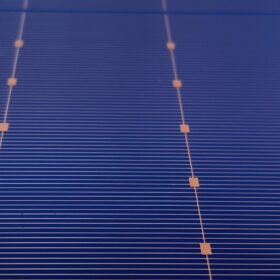Solar wafer price outlook turns pessimistic, global flows shift with evolving trade policies
In a new weekly update for pv magazine, OPIS, a Dow Jones company, provides a quick look at the main price trends in the global PV industry.
Swiss researchers developing control algorithm for grid-forming inverters
Researchers at ETH Zurich have patented a grid-forming inverter algorithm that stabilizes frequency while protecting devices from damage by independently controlling frequency, voltage, and current.
CIGS cell with ultra-thin glass substrate hits record efficiency of 17.81%
South Korean researchers have fabricated a copper indium gallium selenide (CIGS) solar cell with a 90 μm-thick UTG provided by South Korea’s Unique Technology Integral. The device uses a cadmium-free buffer layer made of zinc oxide and magnesium oxide, instead of cadmium sulfide.
Testing floating PV at different heights
Scientists have tested the performance of floating PV panels at a height of 800 mm and 250 mm above their floating structures. Their thermal and electrical performance was compared to that of a reference land-based system and the highest panel was found to show the greatest cooling effect.
Average silver price up 21% in 2024, says Silver Institute
Demand for silver in the PV industry hit 197.6 million ounces in 2024, according to a new report from the Silver Institute. It says the average silver price stood at $28.27 per troy ounce last year, up from $23.35 in 2023.
China identifies major high-purity quartz deposits for PV industry
China has identified two new high-purity quartz deposits as it seeks to localize supply for solar and semiconductor production and reduce dependence on US imports
Fraunhofer ISE developing heterojunction solar cells with silver consumption of less than 2 mg per W
Researchers at the German institute are seeking to reduce silver use in heterojunction PV devices under the umbrella of an extensive research projects. Among their recent achievements there is the fabrication of a heterojunction cell that requires a minimal silver consumption of only 1.4 mg per W.
Fire risks in industrial rooftop solar systems due to poor installation
Clean Energy Associates (CEA) has inspected more than 600 industrial PV systems and has found widespread safety risks, largely stemming from poor installation practices, but many issues are easily identifiable and fixable.
Sungrow releases modular inverter for utility-scale solar
The Chinese manufacturer said its new product uses inverter units with an output of 800 kW, of which 12 can be connected in parallel. It can work in weather of up to 52 C.
Solar cells not exempt from US tariffs despite media reports
Solar cells are not exempt from the recent US reciprocal import tariffs, and recent reporting by major media outlets appears to be a misinterpretation of government documentation.










